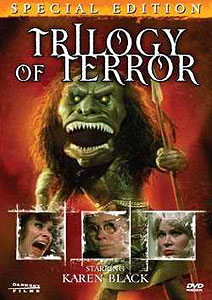 In 1975 when the portmanteau telefilm Trilogy of Terror first aired, it captured a gigantic audience & became one of the television "events" of the year. The whole week following, everyone was talking about Susan Black versus the Zuni fetish doll.
In 1975 when the portmanteau telefilm Trilogy of Terror first aired, it captured a gigantic audience & became one of the television "events" of the year. The whole week following, everyone was talking about Susan Black versus the Zuni fetish doll.
Nowadays with audiences divided between cable, VCR, instant NetFlix downloads to the tv, cell phone videos, & especially the world wide web, we will never again know the feeling of most of America watching the same thing at the same hour & eager for group discussions at school or office watercooler soonafter.
The filmmakers never expected it. The three stories that made up the anthology were based on short stories by Richard Matheson, who personally thought the anthology format was a bad idea because it's hard enough to pull an audience into a feature-length story without expecting them to stay tuned to be drawn in, taken out, drawn in, taken out, three times in one film. But he soon admitted he was wrong.
And though Karen Black starred in better films, this is the one everyone remembers. It's her biggest claim to lasting fame. She created four characters in three stories, so for her it was a true toiur de force of character acting.
But of the three stories it is only the final one that made the lasting impact. The first two parts are good enough tales of murderous insanity & Black does a great job of being psycho. But it is as a woman alone fighting that evil doll that made her one of the immortals of horror cinema.
In the decades sense, evil doll movies have practically become a dime a dozen, but the fact is, even with horror pushed so much further since, that Zuni doll remains one of the scariest damned creatures ever filmed.
It had the perfect design halfway between hideous monster & the sort of African fetish doll someone might actually buy to decorate their home.
It made the most deliciously disgusting chittering growling sounds (uncredited character actor & cartoon voice artist Walker Edmiston does the Zuni doll's voice, & he really should be acknowledged as he gives the disgusting creature so much personality, simultaneously hideous & comical). And it moved fast as a rat, it's knife wildly slashing & stabbing.
Many a soul who saw this as a brand new telefilm remembers literally peeing their pants it was so startling. And all these decades later, watching Trilogy of Terror anew, I was delighted to find that Karen Black's multiple performances are still entertaining, & the Zuni doll is still such a scary buff little bastard he all but eradicates the effect of the first two tales from one's mind.
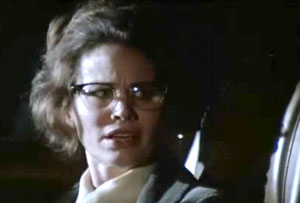 The first story is titled Julie. A great master of the fantasy & science fiction short story, William F. Nolan, wrote the script, based on Matheson's story "The Likeness of Julie Matheson" first published under the name Logan Swanson in a paperback anthology edited by Michael & Don Congdon, Alone by Night (Ballentine, 1962).
The first story is titled Julie. A great master of the fantasy & science fiction short story, William F. Nolan, wrote the script, based on Matheson's story "The Likeness of Julie Matheson" first published under the name Logan Swanson in a paperback anthology edited by Michael & Don Congdon, Alone by Night (Ballentine, 1962).
The reason it was published pseudonymously is because Matheson already had another story in the same anthology under his own name. That one was "Nightmare at Twenty Thousand Feet," which was destined to become one of the most famous of all Twilight Zone episodes.
The original story was about a weird relationship between highschool kids, but Nolan changed it to a college setting . A handsome jock student one day has an idea intrude upon his imagination: that he'd like to see his literature professor naked. It becomes a mania, & he becomes a dangerous stalker.
With a slight name-change from Matheson's original Julia Matheson to Nolan's Julie Eldritch, this seems to have been an intentional use of one of Lovecraft's favorite words, "Eldritch." The story of Julia also includes a swift reference to Bram Stoker's character of Jonathan Harker & it would be like Bill Nolan to stick in such allusions for us horror fans to enjoy.
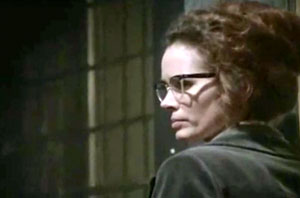 Chad (Robert Berton, to whom Black was married at the time, & who got the role because she insisted) begins fantasizing about Miss Eldritch. Chad (Robert Berton, to whom Black was married at the time, & who got the role because she insisted) begins fantasizing about Miss Eldritch.
Since it dawned on him that underneath the professorial halfway mousy exterior there's a babe in disguise, he can think of nothing else.
While stalking her, he manages to talk her into seeing a movie with him. The film playing at the drive-in is the original Night Stalker (1972), which was actually a telefilm without a theatrical release, from the same director of Trilogy of Terror.
He slips her a date-rape drug, rapes her & takes photos of her body with which to blackmail her into sexual servitude for several weeks.
[SPOILER ALERT] The "twist" ending is that the professor is a serial killer & has been inducing this behavior in young men for quite some while. There's an underdeveloped implication that she has psychic ability to plant rapist mentality in jocks.
For as long as the dirtiness & danger & shame & perverse sex keep her entertatined, she continues to play the victim. But when she finally gets bored, which never takes more than a few weeks, watch out!
The idea of a female serial killer was novel for the era, not so much so now, exploitation cinema being crammed with them, & even a couple historical examples since.
So it's not as shocking today as it was in '75, & it has a couple plot-holes if we're to believe Julie's sister (Kathryn Reynolds) really never noticed Julie's periodic adventurings, & no police detective ever noticed that young men of a specific professor's classes keep dying [END SPOILER ALERT]. It is nevertheless a great little performance for Karen.
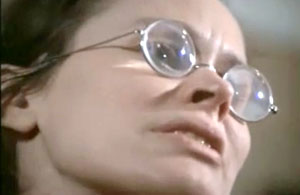 The second story Millicent & Therese has Black playing twin sisters, one a repressed spinster, the other a sexpot & veritable slut. The blonde wig for the sexpot is insufficient to make her sexy, alas, which fact weakens the episode. She's actually sexier without make-up & wearing the buggy-eye glasses of the spinster.
The second story Millicent & Therese has Black playing twin sisters, one a repressed spinster, the other a sexpot & veritable slut. The blonde wig for the sexpot is insufficient to make her sexy, alas, which fact weakens the episode. She's actually sexier without make-up & wearing the buggy-eye glasses of the spinster.
Richard Matheson's original short story was no more than a vignette, "Needle in the Heart" from Ellery Queen's Mystery Magazine (October, 1969), sometimes reprinted as "Therese." There wasn't enough to it to make even a third of a movie, so once again William F. Nolan has made it practically his own story in the adaptation.
[SPOILER ALERT] Since it's obvious from the start there aren't really two sisters, but a nutter with split personality, there's no "surprise" to the twist, so it's the performance & not the story that matters.
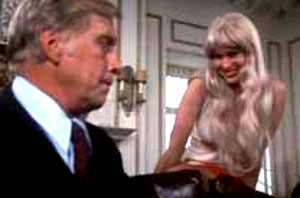 Millicent is scared shlitless of her dynamic nymphoid sister, who she believes uses black magic to get her way in life. Millicent is scared shlitless of her dynamic nymphoid sister, who she believes uses black magic to get her way in life.
Referencing her sister's books on satanism & spells, she decides to turn the tables & be rid of Therese by means of a voodoo doll. The magic works, but Milly has actually killed herself with the spell [END SPOILER ALERT].
The least of the three tales, it's nevertheless interesting to watch Black create two characters. The deluxe dvd release of the film includes a commentary track with Karen Black & William F. Nolan discussing the first two episodes (Bill leaves without commenting on the third episode which he did not script).
Bill notes that this film is often mentioned to him when he meets horror fans. But the initial praise wilts when the only part they remember is about the Zuni doll, which he had no hand in, & which is likely why he couldn't find his way to stick around & add a few opinions of the final third of the film.
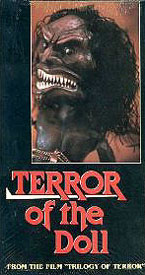 The third episode Amelia, recycled separately in the vhs era as Terror of the Doll.
The third episode Amelia, recycled separately in the vhs era as Terror of the Doll.
It is based on Matheson's short story "Prey" which had its first publication in Playboy (April, 1969), which also featured his great novelette "Duel" (Playboy, April 1971) which likewise became a famous telefilm, Stephen Spielberg's Duel (1971).
In the week of its first appearance there were many reviews of Trilogy of Terror, mostly positive, mostly about the Zuni doll episode. The film has since landed on top-ten lists of best evil dolls, top-100 lists of all time greatest horror films, & never lost its cult status.
The Zuni doll was even manufactured as an action figure & has seeped into the culture as iconic And frankly, without the Zuni doll, Trilogy of Terror would likely be as little-considered as Dan Curtis's extremely similar follow-up trilogy, Dead of Night (1977)..
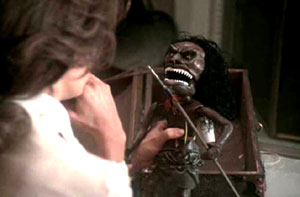 The film was the result of an intended anthology series Dan Curtis failed to sell in 1959. He never quite gave up on his idea for a series in the manner of The Twilight Zone focusing on the works of serious writers of horror short stories. The film was the result of an intended anthology series Dan Curtis failed to sell in 1959. He never quite gave up on his idea for a series in the manner of The Twilight Zone focusing on the works of serious writers of horror short stories.
Trilogy of Terror wasn't really produced as a pilot movie as often stated, but Curtis always had in the back of his mind the possibility of finally getting his anthology series off the ground, & by bunching half-hour episodes into Trilogy of Terror & Dead of Night, the films could later be broken down into individual episodes.
At the time Karen Black felt that the unexpected popularity of Trilogy of Terror changed her career for the worse. She'd previously gained notice for such significant roles for The Great Gatsby (1974), Five Easy Pieces (1970), & Easy Rider (1969), & was well known as Hollywood's most beautiful crosseyed leading lady with artistic integrity into the bargain. Though before Trilogy she had already showed her chops in a fine little horror film The Pyx (1973).
In the wake of her scream-queen outing in Amelia & psycho performances in the other two parts of Trilogy of Terror, she found herself most easily employed in scary films, beginning with such great examples as The Day of the Locust (1975) & Dan Curtis's excellent Burnt Offerings (1976).
More recent interviews have her seeming a little more prideful if still ambivilant about her B-movie work. Fact is, good looking though she remains as an old lady, it's her status as a horror movie maven that has kept her employable right up to Mirror Mirror (1990), Night Angel (1990), I Woke Up Early the Day I Died (1998), Soulkeeper (2001), House of 1000 Corpses (2003), & a score others.
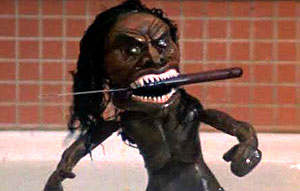 As to the "Amelia," really that appalling, toothy, buff little Zuni doll has never been equalled in evil doll movies since, not in Puppet Master (1989) or sequels, not in Child's Play (1988) or sequels, & not in the many other films that owe so much to that devlish little doll whose name is He Who Kills. As to the "Amelia," really that appalling, toothy, buff little Zuni doll has never been equalled in evil doll movies since, not in Puppet Master (1989) or sequels, not in Child's Play (1988) or sequels, & not in the many other films that owe so much to that devlish little doll whose name is He Who Kills.
His design, & the sounds he makes courtesy of Walker Edmiston, his speed & delverness, just scares the crap out of you. At the same time, it's really quite comical, something that small that scary, chittering like a dump rat, zipping about insistent on just being as dangerous as a much larger threat. But like that dump rat, if you had a rabid toothy rodent chasing you around the apartment, even not armed with a knife & cunning, you know damned well you'd be just that scared.
Karen is the only character, other than the doll, who appears on screen. The doll so upstages her Karen is sometimes deprived of her full measure of praise for a unique achievement. The film as a whole truly is a tour de force, but this one role requires her to go from unsuspecting & naive, to scared near to death, to heroic, & finally to a suprise shift in the last scene that kept many a viewer in 1975 awake for a week. That was all her.
And she even manages to make it seem like there was another character in the story -- Amelia's domineering mother whose existence is only implied by one-sided phone conversations -- & this induced belief in one more cast member is part of what makes the final climax so shocking.
Significantly, Karen contributed to the film's text in many ways, but it should especially be noted that the very final image of horror with Amelia holding that knife, that was Karen Black's idea. Richard Matheson did not think of it in either his original story nor the screenplay. Karen brought her notion for the ending to Dan Curtis, who was dubious it would work, but decided to give it a try.
And while it will always be the Zuni doll that excites commentaries about this film, realistically the doll isn't seriously well-articulated or convincing without it's intended victim making it seem a real threat, & the climax would not have been so stunning had it been the "happy" ending Matheson's script supplied.
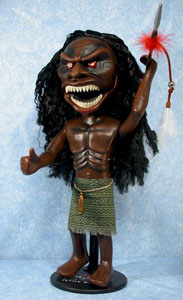 The Dark Sky special dvd edition of Trilogy of Terror has lovely extras lacking in the long out of print VHS release, including two original featurettes.
The Dark Sky special dvd edition of Trilogy of Terror has lovely extras lacking in the long out of print VHS release, including two original featurettes.
A hair under eleven minutes is Richard Matheson: Terror Scribe (2006). It's an interview with Matheson discussing his novels, short stories, & screenplays, his work with Dan Curtis, Rod Serling & others, & especially about Trilogy of Terror. Personable, honest, witty, with a curmudgeonly bit about how rotten horror has gotten today.
Almost seventeen minutes is an interview with Karen Black, Three Colors of Black (2006). She duscusses her career from stage plays to cinema. It's nice she's still a beauty, even if an aged one, & some comes off intelligent with interesting observations.
We learn a lot about her memories of filming Trilogy of Terror, how she almost turned down the role, how she personally came up with the idea for the film's final image, her interest in character-acting generally, though much that she has to say gets repeated on the commentary track.
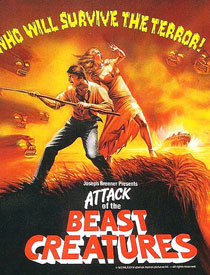 The legacy of Trilogy of Terror has never waned. Such franchises as the Puppet Master series & the Child's Play films owe everything to that Zuni doll, not to mention a literal sequel bringing the fetish doll back for Trilogy of Terror II (1995), to be reviewed in the near future.
The legacy of Trilogy of Terror has never waned. Such franchises as the Puppet Master series & the Child's Play films owe everything to that Zuni doll, not to mention a literal sequel bringing the fetish doll back for Trilogy of Terror II (1995), to be reviewed in the near future.
The infamous doll also has a cameo appearance standing in a trophy case in Stephen King's Nightmares & Dreamscapes: Battleground (2006). And our enraged Zuni doll turns up in a new incarnation as Oooga Booga in Doll Graveyard (2005), plus Ooga Booga has his own cameo in Evil Bong (2006).
The army of Zuni fetish dolls in the no-budget gore flick Attack of the Beast Creatures (1985) pay homage to Trilogy of Terror.
Even though the doll is recreated rather badly, & comedy is more important than terror, even so, the desigh is so close to the original that a certain spooky intensity results when multiples of the little bastard go after the shipwreck survivors who are running about in the woods for a gore fest of guys & gals wrastlin' with dolls.
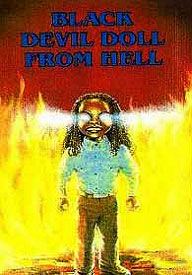 Black Devil Doll from Hell (1984) is so low budget it barely even registers as a film. Even so, in spite of being no more than a hand-held home-video, it has distinct amateur charm. Black Devil Doll from Hell (1984) is so low budget it barely even registers as a film. Even so, in spite of being no more than a hand-held home-video, it has distinct amateur charm.
As I write this it's only available in very poor copy through the grey market, & there's a good chance no quality copy even survives for this independent blaxploitation product.
Shirley L. Jones stars in Karen Black's role, & even has the in-homage character-name of Helen Black. The evil doll isn't the Zuni fetish doll, but was avowedly inspired by it.
The doll is much more of a psycho pimp puppet with dreadlocks, & vulgar mouth, & a slasher mentality.
It's only good for laughing at, as every aspect of the film is ridiculous, & the amount of padding (even in the credits) to get it to over an hour's length has a feeling of desparation. A lot of the time the puppet is just shown standing still, or it's eyes are shown looking left then right, as it couldn't do much else.
Continue to the next evil doll:
Doll Graveyard (2005)
copyright © by Paghat the Ratgirl
|
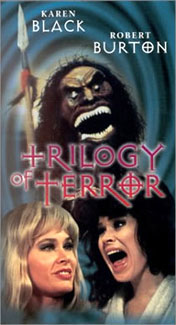

 The first story is titled Julie. A great master of the fantasy & science fiction short story, William F. Nolan, wrote the script, based on Matheson's story "The Likeness of Julie Matheson" first published under the name Logan Swanson in a paperback anthology edited by Michael & Don Congdon, Alone by Night (Ballentine, 1962).
The first story is titled Julie. A great master of the fantasy & science fiction short story, William F. Nolan, wrote the script, based on Matheson's story "The Likeness of Julie Matheson" first published under the name Logan Swanson in a paperback anthology edited by Michael & Don Congdon, Alone by Night (Ballentine, 1962). Chad (Robert Berton, to whom Black was married at the time, & who got the role because she insisted) begins fantasizing about Miss Eldritch.
Chad (Robert Berton, to whom Black was married at the time, & who got the role because she insisted) begins fantasizing about Miss Eldritch. The second story Millicent & Therese has Black playing twin sisters, one a repressed spinster, the other a sexpot & veritable slut. The blonde wig for the sexpot is insufficient to make her sexy, alas, which fact weakens the episode. She's actually sexier without make-up & wearing the buggy-eye glasses of the spinster.
The second story Millicent & Therese has Black playing twin sisters, one a repressed spinster, the other a sexpot & veritable slut. The blonde wig for the sexpot is insufficient to make her sexy, alas, which fact weakens the episode. She's actually sexier without make-up & wearing the buggy-eye glasses of the spinster. Millicent is scared shlitless of her dynamic nymphoid sister, who she believes uses black magic to get her way in life.
Millicent is scared shlitless of her dynamic nymphoid sister, who she believes uses black magic to get her way in life. The third episode Amelia, recycled separately in the vhs era as Terror of the Doll.
The third episode Amelia, recycled separately in the vhs era as Terror of the Doll. The film was the result of an intended anthology series Dan Curtis failed to sell in 1959. He never quite gave up on his idea for a series in the manner of The Twilight Zone focusing on the works of serious writers of horror short stories.
The film was the result of an intended anthology series Dan Curtis failed to sell in 1959. He never quite gave up on his idea for a series in the manner of The Twilight Zone focusing on the works of serious writers of horror short stories. As to the "Amelia," really that appalling, toothy, buff little Zuni doll has never been equalled in evil doll movies since, not in
As to the "Amelia," really that appalling, toothy, buff little Zuni doll has never been equalled in evil doll movies since, not in  The Dark Sky special dvd edition of Trilogy of Terror has lovely extras lacking in the long out of print VHS release, including two original featurettes.
The Dark Sky special dvd edition of Trilogy of Terror has lovely extras lacking in the long out of print VHS release, including two original featurettes. The legacy of Trilogy of Terror has never waned. Such franchises as the Puppet Master series & the Child's Play films owe everything to that Zuni doll, not to mention a literal sequel bringing the fetish doll back for Trilogy of Terror II (1995), to be reviewed in the near future.
The legacy of Trilogy of Terror has never waned. Such franchises as the Puppet Master series & the Child's Play films owe everything to that Zuni doll, not to mention a literal sequel bringing the fetish doll back for Trilogy of Terror II (1995), to be reviewed in the near future. Black Devil Doll from Hell (1984) is so low budget it barely even registers as a film. Even so, in spite of being no more than a hand-held home-video, it has distinct amateur charm.
Black Devil Doll from Hell (1984) is so low budget it barely even registers as a film. Even so, in spite of being no more than a hand-held home-video, it has distinct amateur charm.